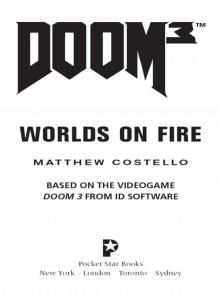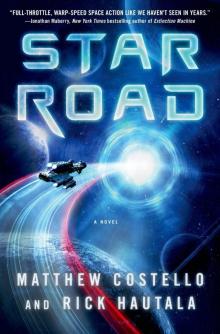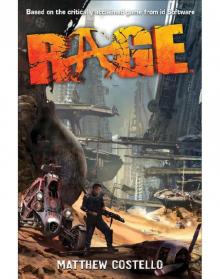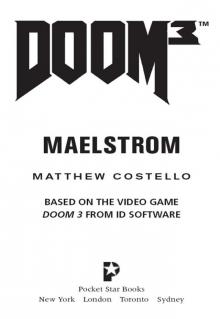- Home
- Matthew Costello
Doom 3™: Maelstrom
Doom 3™: Maelstrom Read online
KANE COULD BARELY MAKE OUT
THE SHAPES IN FRONT OF HIM.
IF HE HADN’T LIVED THROUGH THE PAST HOURS he might have thought…dogs. There are three dogs in front of me. Cutting me off.
But he could be sure that they weren’t dogs. Even in the half-light he could see that they looked like the things he blew to pieces in the restroom above. He didn’t ask himself what they were then…and he wasn’t going to now.
One of the creatures moved to the side. He saw another look back as if considering moving in another direction. Which is when the third one leaped at him.
The creature’s powerful hind legs sent it—so big and bulky—flying right at him. More of the animal came into the light and Kane could see the head. A gaping hole filled with teeth…
Pocket Star Books
A Division of Simon & Schuster, Inc.
1230 Avenue of the Americas
New York, NY 10020
This book is a work of fiction. Names, characters, places, and incidents either are products of the author’s imagination or are used fictitiously. Any resemblance to actual events or locales or persons, living or dead, is entirely coincidental.
Copyright © 2009 by Id Software, Inc. All rights reserved. Doom® and ID are registered trademarks of Id Software Inc.
All rights reserved, including the right to reproduce this book or portions thereof in any form whatsoever. For information address Pocket Books Subsidiary Rights Department, 1230 Avenue of the Americas, New York, NY 10020.
POCKET STAR and colophon are registered trademarks of Simon & Schuster, Inc.
The Simon & Schuster Speakers Bureau can bring authors to your live event. For more information or to book an event contact the Simon & Schuster Speakers Bureau at 866-248-3049 or visit our website at www.simonspeakers.com.
ISBN-13: 978-1-4391-5855-5
ISBN-10: 1-4391-5855-X
Visit us on the World Wide Web:
http://www.SimonSays.com
To Tim Willits…
A good person to know on Earth…and Mars…when
the monsters come.
CONTENTS
2145
TWO DAYS BEFORE THE FIRST OUTBREAK
1
2
3
4
5
6
2145
ARMAGEDDON
7
8
9
10
11
12
13
14
15
16
17
18
19
20
21
22
23
24
25
26
27
28
29
30
31
32
2145
INTO HELL
33
34
35
36
37
38
39
40
41
42
43
EPILOGUE
44
ABOUT THE AUTHOR
2145
TWO DAYS BEFORE THE FIRST OUTBREAK
1
THE MID-ATLANTIC RIDGE THE ROBERT BALLARD DEEP OCEAN LAB DEPTH: 18,674 FEET, OUTSIDE TEMPERATURE: 178 DEGREES FAHRENHEIT DATE: 03_11_2145
DAVID RODRIGUEZ LOOKED AT A SEISMIC map of the ocean floor, focusing on the mammoth Mid-Atlantic Ridge—the world’s greatest mountain chain, although miles under the surface of the ocean.
He saw a massive network of fissures—potential problem areas—all at different depths, spread throughout the ridge. Each area fed a steady stream of real-time information to the lab’s computers.
Only days ago the lab got an early warning about a good-sized plate shift that was bound to produce some major fissures. But the information coming from the probes—detailing the stress to the continental plates, the depth of bedrock, the possible path of erupting magma—showed that the Ballard Lab itself was not in any danger. Good thing too. An evacuation would be costly, not to mention years of work lost down the hydrothermal tube.
But the probes also showed that this latest seismic spur would create a new series of thermal spouts not too far from the lab.
David turned back to the open work area behind him. Giant tanks housed specimens, all surrounded by teams of his scientists working at self-contained modules near the tanks. No closed offices or lab rooms here—as lab director, David Rodriguez had a say in the design and he wanted everyone coming down here to feel that no matter what they were working on, they were all part of a team.
What one discovers, we all discover, he always told them.
And though practically everyone down here was bristling with credentials—many more so than others—there would be no “Doctor this” or “Doctor that.” Including Rodriguez himself.
“¿Ola, Tomas, cómo van las cosas hoy?”
Tomas, who held advanced degrees in genetic microbiology and molecular physics, looked up and smiled. “Muy bien, David. Though we hope to get our hands on some of the new samples”—he nodded his head to the great ocean past the massive walls of the lab—“out there.”
David laughed. “I’m going out there soon. Just waiting until things settle down a bit.” He turned to the big 3-D view of the ocean floor behind him. “So far, things are looking good.”
“I know. This really could be the opportunity we’ve been waiting for.”
David nodded in agreement, and started for the east end of the podlike lab.
Amazingly, the design of the lab’s transport pod was based on an old vid about space travel. Even the submersibles were modeled on the shape of the EVA vehicles on the spaceship in that film called 2001, now nearly 200 years old. Not that anyone really watched the old vids anymore.
But that carefully researched design for space made absolutely perfect sense for the deep ocean environment, where the pressure could get close to one thousand atmospheres and the temperature plunged to well below the zero mark, though nothing ever froze thanks to the water salinity.
The door to the submersible bay opened, and Julie Chao walked in.
“Morning,” David said quickly.
Once they had been together, back at Woods Hole—partners in life and in science. Not anymore. But when he planned the lab, he knew he’d want Julie working with the team. Both thought they could get past their past. Easier said than done, David realized.
But then, they both worked hard to remain professional and to avoid any letting down of their guard and slipping into—what? Friendship? Remembrance? Nostalgia for the good times they had? Or maybe bitterness at how and why it ended?
“Is it morning? I gave up keeping track of when it’s day or night. How quaint of you to keep it up,” Julie remarked.
He smiled. She always did have a bit of an edge.
“Right. Okay, everything all checked out at your end?”
Julie nodded, even as she slipped into the bulky suit that would provide an extra measure of temperature protection should they hit an area where the thermal currents spiked and the water went from below zero to two hundred degrees in seconds.
“Yup, all set. Everyone’s excited about getting samples from the new vents.”
“I know. Completely virgin compounds in the process of being—I don’t know—born.”
She laughed at that. “If you can call it birth.” Then she looked at him. “You are coming along with me, right?”
David nodded. “Right. I’ll suit up. We’ll take submersible number one.”
“Doesn’t matter to me.”
With that, David s
tarted getting into his suit, checking as he did that the biometric functions kicked in, tracking all his vital signs, sending the information to the lab. When he was ready, the technicians opened up the first sub door and David followed Julie into the incredibly tight space.
“Okay. All set here,” David said.
“Roger, David. Airlock closed behind you. Julie, all your equipment reading okay?”
“Everything’s fine,” Julie said.
“Right. Ejection in thirty seconds.”
They sat there and waited. David turned to Julie, who looked straight ahead, eyes on the Christmas tree—like an array of colorful buttons and lights. The submersible had three small ports, one dead ahead and two others to the side. Because of the tremendous pressure, the windows to the outside world had to be small, and the reinforced polymer “glass” inches thick.
The sub was silently and smoothly ejected through the airlock.
The outside cameras provided a much better view than could be seen in the port in front of either passenger. Now the screens above them showed the view as the sub glided away from the lab toward the underwater mountain range, the Mid-Atlantic Ridge.
Years ago, David’s team had navigated and mapped a series of valleys that cut into the nearest undersea mountains. David knew which valley gave them a clear shot to HTVR-1138—the new Hydrothermal Vent Region 1138.
Now Julie guided the sub between two massive mounds with just enough space to slip between them. Some abyssal creatures, a light-dangling angler fish and the always bizarre pelican gulper eel, came by to explore.
They don’t get many visitors around here.
“Everything good, Julie?”
“Yup—nice and smooth. The temp readings are about what we’d expect.”
David knew that these subs were not the newest toys out of the UAC’s box. Their real attention stayed locked on Mars and the much-vaunted Mars City. This deep-ocean lab had turned into a neglected sideshow for Kelliher and his team of advisers in California.
Was the day coming that it would be shut down? That could well happen if nothing practical came out of the lab, and soon. The lab had been promoted to the world as a general oceanic research center specializing in finding new methods of desalinization and use of ocean resources, but David knew that—for the UAC—there was a much larger goal. Toward which there had been very little progress.
“Whoa—there’s something!” Julie tapped a button in front of her.
David looked down and saw that the outside water temperature was beginning to spike. Which meant that a current of superheated water had just hit the sub.
“Think we’re okay to go on?”
“For now. But we best watch it. Got the new vent field coming up dead ahead.”
David looked at the large screen above their heads. Twin Cameron lenses provided a wavy 3-D image of the world ahead—wavy due to the blurring effect of the volcanically heated water.
And as the sub glided forward almost soundlessly, both of them gazed at a sight that simply never became anything less than staggering.
First they saw the crab colonies—gatherings of giant albino crabs that, unlike their more prosaic seashore cousins, worked and hunted together, acting more like ants. The fact that they were bleach-white and each was the size of a kitchen table always made the initial glimpse of this alternate world an amazing one.
Then they spotted other crustaceans hanging around the periphery, perhaps hoping to scarf up whatever the crabs left over. One of them—for David, the most disturbing creature down here—was the gyanthomous, an isopod the size of a golden retriever. To witness it was to think that it was impossible that it came from Earth.
“Tube worms coming up,” Julie said.
From out of the mist of blurry volcanic water and flecks of debris, David watched the field of tube worms appear. These worms—some standing twenty to thirty feet tall—were the true dominant life-form down here. The tube worms hosted the parasitic bacteria that somehow took the sulfurous water, poisonous to any other creature, and turned it into food that the worms then consumed. A perfect and incredible symbiotic relationship. And the fact that the food produced resembled hemoglobin in its chemical makeup was still something that confused scientists, even a hundred years after the worms’ discovery by Robert Ballard. Many of the station’s best teams worked on finding out where this life came from, how it developed, and how it might evolve in the future.
Julie edged the small sub up and sailed it above the massive tube worm field, as the worms repeatedly sucked in the poisonous water, each feeding its own colony of bacteria. The sharp temperature spike—the stray current—seemed to have veered away.
“Always something to see, isn’t it?” David said.
“That’s for sure.”
Something—as in a complete ecosystem that has absolutely nothing to do with photosynthesis. Nothing to do with any system of life found on the surface at all. This was as close to an alien world as David could imagine.
Yet, here it was, ancient, thriving—and David, along with the others on his team, felt it had things to say. About planet Earth. About humanity. Maybe about humanity’s ability to survive.
Let everyone else keep their eyes on Mars. For David, down here was where the real mystery of life lay.
“Okay, going to start heading over toward the new vents,” Julie said.
David nodded as she banked the submersible to the right, away from this mature vent field, away from the looming “smokers” ahead—the mini-volcano-like openings—to where Mother Earth had just recently cracked open a bit more.
And life—a different kind of life—was about to begin.
2
“THERE WE ARE,” JULIE SAID, LEANING CLOSER to the porthole.
“Got a better view on the screen here.”
She turned to David and smiled. “I like seeing the real thing. I’m kinda old-school that way.” Julie turned back to the screen.
David looked at the 3-D image, which made it appear as if the open fissures and new smokers were inside the submersible.
“Always amazing,” he said. “The earth opens up, and hundreds of degrees of molten magma gets squeezed out. Beautiful—”
“Yeah, and a bit terrifying, too. We best get busy gathering the samples.”
David leaned down and grabbed the handle-like grip of the controllers for the sub’s left arm. The controllers allowed for a variety of deep-ocean operations. To start, David began collecting water samples, the amount of sulfurous and chemical material rising with each sample. Julie did the same thing with the other arm, but then she stopped and took the submersible down a few feet closer to the surface.
“Now for some bottom grabs,” she announced. The goal was to get a range of samples that showed the increased concentration of the strange chemical mixture, which might lead to an understanding of the origins of this bizarre ecosystem of hydrothermal vents.
David hit some control buttons for his exterior arm, and now the claw shifted and he could carefully scoop the top layer of ocean bottom material, which already bore a frosting of the debris that drifted over from the smokers.
“How you doing?” Julie asked.
“Good. And the temps? Time to turn around?”
“Whoa—yeah. Must be a big fissure. Heat’s getting up there fast. We got what everyone wanted. New material, freshly deposited. So—”
David looked up at the screen. The open fissure was closer now, the new chimneylike smokers pouring out a steady stream of superheated water and magma. He waited, expecting to see the submersible start rising and then sharply banking away for the volcanic area ahead. When it didn’t move, he said, “Julie?”
“We’ve got a problem…. Engine’s not responding. We’re heading straight toward the new vent area.”
“Umm…ideas?”
“I—”
David could see the other controls responding normally, including the temperature gauges, which now began to sound a single shrill beep. Not
loud, not yet—
“Julie? It’s your call.”
She turned to him. “Really? Okay, I’m thinking.” She shook her head. Whatever it was she was going to do, it better be damn fast. “Okay. My call. Only one thing I can see that we can do. Shut the whole thing down. Then a full system restart and hope the engine controls come back online.”
“What…are we in the Stone Age? Turn it off?”
“You said it’s my call. It’s all—”
“Fine. Do it.”
As fast as she could, Julie hit the master control switches that shut down every system on the submersible, from the air scrubbers to the massive interconnected electronics packed into the small sub.
Then…they floated, suspended in the dark, still only feet from the bottom, the air immediately turning stale, the temperature climbing by the second.
David held his breath, knowing that Julie would wait a precious few more seconds until she thought every system was truly down and off. He tried not to count.
Then he heard her: “Okay.” She started to throw the switches, moving faster than he ever saw any human move before. She followed the standard progression, internal electronics, system monitoring, outside data electronics, air scrubber, and finally main and secondary thrusters.
The warning beep immediately returned, but now as a steady, constant ping that was deafening. David forced himself to look away from the temperature screens. He didn’t need confirmation of what he could feel.

 Cherringham--Too Many Lies
Cherringham--Too Many Lies Mydworth Mysteries - A Shot in the Dark (A Cosy Historical Mystery Series Book 1)
Mydworth Mysteries - A Shot in the Dark (A Cosy Historical Mystery Series Book 1) Cherringham--The Gentleman Vanishes
Cherringham--The Gentleman Vanishes Cherringham--Cliffhanger
Cherringham--Cliffhanger Beneath Still Waters
Beneath Still Waters Cherringham--Trail of Lies
Cherringham--Trail of Lies The Gentleman Vanishes
The Gentleman Vanishes Mydworth Mysteries--Murder wore a Mask
Mydworth Mysteries--Murder wore a Mask Mydworth Mysteries--London Calling!
Mydworth Mysteries--London Calling! Cherringham--Killing Time
Cherringham--Killing Time Mydworth Mysteries--The Wrong Man
Mydworth Mysteries--The Wrong Man Cherringham - The Drowned Man
Cherringham - The Drowned Man Cherringham--Killer Track
Cherringham--Killer Track Cherringham--The Secret of Brimley Manor
Cherringham--The Secret of Brimley Manor A Deadly Confession
A Deadly Confession Cherringham--Murder under the Sun
Cherringham--Murder under the Sun Cherringham - A Dinner to Die For
Cherringham - A Dinner to Die For Family
Family Cherringham--Death Trap
Cherringham--Death Trap Cherringham--The Curse of Mabb's Farm
Cherringham--The Curse of Mabb's Farm Vacation
Vacation Cherringham--A Bad Lie
Cherringham--A Bad Lie Doom 3™: Worlds on Fire
Doom 3™: Worlds on Fire Cherringham--Scared to Death
Cherringham--Scared to Death Home
Home Dead in the Water
Dead in the Water Star Road
Star Road Rage
Rage Cherringham--A Fatal Fall
Cherringham--A Fatal Fall Jack Murphy_Prequel_Day One
Jack Murphy_Prequel_Day One Doom 3™: Maelstrom
Doom 3™: Maelstrom